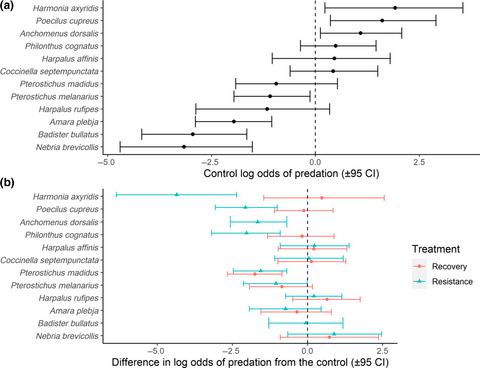当前位置:
X-MOL 学术
›
J. Appl. Ecol.
›
论文详情
Our official English website, www.x-mol.net, welcomes your
feedback! (Note: you will need to create a separate account there.)
Invertebrate community structure predicts natural pest control resilience to insecticide exposure
Journal of Applied Ecology ( IF 5.0 ) Pub Date : 2020-09-24 , DOI: 10.1111/1365-2664.13752 Arran Greenop 1, 2 , Samantha M. Cook 3 , Andrew Wilby 2 , Richard F. Pywell 1 , Ben A. Woodcock 1
Journal of Applied Ecology ( IF 5.0 ) Pub Date : 2020-09-24 , DOI: 10.1111/1365-2664.13752 Arran Greenop 1, 2 , Samantha M. Cook 3 , Andrew Wilby 2 , Richard F. Pywell 1 , Ben A. Woodcock 1
Affiliation

|
1. Biological pest control has become one of the central principles of ecological intensification in agriculture. However, invertebrate natural enemies within agricultural ecosystems are exposed to a myriad of different pesticides at both lethal and sub-lethal doses, that may limit their capacity to carry out pest control. An important question is how underlying diversity in invertebrate predator species, linked to their unique susceptibility to insecticides, can act to increase the resilience of natural pest control. 2. We explore this issue by assessing the effects of sub-lethal insecticide exposure on the predation rates of 12 generalist predators feeding on the aphid Sitobion avenae (Aphididae). Predation rates within a 24-hr period were assessed (predation assessment) for each species after receiving one of the following treatments: (a) no prior deltamethrin exposure before the predation assessment (control); (b) deltamethrin exposure immediately before the predation assessment (resistance) and (c) deltamethrin exposure 5 days before the predation assessment (recovery). Extrapolating from these species-specific measures of resistance and recovery, we predicted the resilience of community level predation to insecticide exposure for predator communities associated with 256 arable fields in the UK. 3. There was large variation in sub-lethal effects of the insecticide between even closely related species. This ranged from species showing no change in predation rates following sub-lethal insecticide exposure (high resistance), species showing only immediate depressed feeding rates after 24 hr (high recovery) or those with depressed feeding rates after 5 days (low resistance and recovery). 4. The community level analysis showed that resistance and recovery of natural pest control was predicted by both community phylogenetic diversity (positively) and weighted mean body mass (negatively). However, the removal of numerically dominant species from the analysis modified these effects. 5. Synthesis and applications: Our results highlight the role of community diversity in maintaining the resilience of natural pest control following insecticide use. Importantly, less diverse assemblages dominated by predator species that show low resilience to insecticide exposure, may show a greater depression in pest control than diverse assemblages under insecticide based farmland management.
中文翻译:

无脊椎动物群落结构预测害虫自然防治对杀虫剂暴露的恢复能力
1. 生物害虫防治已成为农业生态集约化的核心原则之一。然而,农业生态系统中的无脊椎动物天敌暴露于致死和亚致死剂量的无数不同杀虫剂中,这可能会限制它们进行虫害防治的能力。一个重要的问题是,无脊椎动物捕食者物种的潜在多样性与其对杀虫剂的独特敏感性有关,如何能够提高自然害虫防治的弹性。2. 我们通过评估亚致死杀虫剂暴露对 12 种以蚜虫 Sitobion avenae (Aphididae) 为食的多面手捕食者的捕食率的影响来探讨这个问题。在接受以下治疗之一后,对每个物种在 24 小时内的捕食率进行评估(捕食评估):(a) 在捕食评估(对照)之前没有先前的溴氰菊酯暴露;(b) 在捕食评估 (抗性) 之前立即接触溴氰菊酯和 (c) 在捕食评估 (恢复) 前 5 天接触溴氰菊酯。根据这些特定物种的抗性和恢复措施,我们预测了与英国 256 个耕地相关的捕食者社区的社区水平捕食对杀虫剂暴露的恢复能力。3. 即使是亲缘关系密切的物种之间,杀虫剂的亚致死作用也存在很大差异。这包括在亚致死性杀虫剂暴露(高抗性)后捕食率没有变化的物种,24 小时后仅表现出立即降低进食率的物种(高恢复)或 5 天后进食率降低的物种(低抵抗和恢复)。4. 群落水平分析表明,群落系统发育多样性(正值)和加权平均体重(负值)都预测了自然害虫防治的抗性和恢复。然而,从分析中去除数量上占优势的物种改变了这些影响。5. 合成和应用:我们的研究结果强调了群落多样性在使用杀虫剂后保持自然害虫防治弹性方面的作用。重要的是,由对杀虫剂暴露的抵抗力低的捕食者物种主导的多样性较少的组合,
更新日期:2020-09-24
中文翻译:

无脊椎动物群落结构预测害虫自然防治对杀虫剂暴露的恢复能力
1. 生物害虫防治已成为农业生态集约化的核心原则之一。然而,农业生态系统中的无脊椎动物天敌暴露于致死和亚致死剂量的无数不同杀虫剂中,这可能会限制它们进行虫害防治的能力。一个重要的问题是,无脊椎动物捕食者物种的潜在多样性与其对杀虫剂的独特敏感性有关,如何能够提高自然害虫防治的弹性。2. 我们通过评估亚致死杀虫剂暴露对 12 种以蚜虫 Sitobion avenae (Aphididae) 为食的多面手捕食者的捕食率的影响来探讨这个问题。在接受以下治疗之一后,对每个物种在 24 小时内的捕食率进行评估(捕食评估):(a) 在捕食评估(对照)之前没有先前的溴氰菊酯暴露;(b) 在捕食评估 (抗性) 之前立即接触溴氰菊酯和 (c) 在捕食评估 (恢复) 前 5 天接触溴氰菊酯。根据这些特定物种的抗性和恢复措施,我们预测了与英国 256 个耕地相关的捕食者社区的社区水平捕食对杀虫剂暴露的恢复能力。3. 即使是亲缘关系密切的物种之间,杀虫剂的亚致死作用也存在很大差异。这包括在亚致死性杀虫剂暴露(高抗性)后捕食率没有变化的物种,24 小时后仅表现出立即降低进食率的物种(高恢复)或 5 天后进食率降低的物种(低抵抗和恢复)。4. 群落水平分析表明,群落系统发育多样性(正值)和加权平均体重(负值)都预测了自然害虫防治的抗性和恢复。然而,从分析中去除数量上占优势的物种改变了这些影响。5. 合成和应用:我们的研究结果强调了群落多样性在使用杀虫剂后保持自然害虫防治弹性方面的作用。重要的是,由对杀虫剂暴露的抵抗力低的捕食者物种主导的多样性较少的组合,











































 京公网安备 11010802027423号
京公网安备 11010802027423号